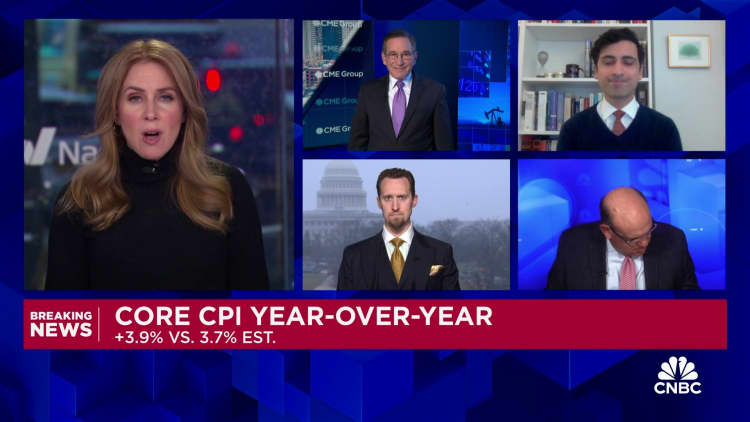Customers shop at an RC Willey home furnishings store in Draper, Utah, Aug. 28, 2023.
George Frey/Bloomberg via Getty Images
Inflation has pulled back significantly from its pandemic-era peak. In fact, some categories have fallen into outright deflation, meaning consumers are seeing the prices decline instead of rise.
Deflation has largely occurred among physical goods rather than services, economists said. The former are tangible objects, while the latter are largely things we can experience, like haircuts and veterinary visits.
Demand for goods soared early in the Covid-19 pandemic, as consumers were confined to their homes and couldn’t spend on things such as travel or concerts. The health crisis also snarled global supply chains, meaning volume couldn’t keep pace with demand for those goods. Such supply-and-demand dynamics drove up prices.
Now, they’re falling back to earth.
So-called “core” goods inflation â which exclude food and energy prices, which can be volatile â was negative 0.3% in January 2024 relative to a year earlier, according to the latest consumer price index data issued Tuesday by the U.S. Bureau of Labor Statistics.
“Supply chains are going back to normal,” said Jay Bryson, chief economist for Wells Fargo Economics. “And on the demand side, there’s been somewhat of a rotation from goods spending back toward services spending.”
“We’re kind of reverting back to the pre-Covid era,” he added.
A shift away from spending on goods
Average prices have deflated for these physical goods, among others, from January 2023 to January 2024: furniture and bedding (prices have fallen by 2.9%); major household appliances (-7.3%); men’s suits, sport coats and outerwear (-5.3%); girls’ apparel (-9%); video and audio products (-5.8%); sporting goods (-1.1%); toys (-4.2%); and college textbooks (-5.7%), according to CPI data.
Prices for used cars and trucks have also deflated over the past year, by 3.5%, according to CPI data.
Used and new vehicle prices were among the first to surge when the U.S. economy reopened broadly early in 2021, amid a shortage of semiconductor chips essential for manufacturing.
These are the big deflationary factors
“A lot of factors have come together to push goods prices down,” said Mark Zandi, chief economist at Moody’s Analytics.
In addition to normalizing supply-demand dynamics, a historically strong U.S. dollar relative to other global currencies has also helped rein in goods prices, Zandi said. This makes it cheaper for U.S. companies to import goods from overseas, since the dollar can buy more.
The Nominal Broad U.S. Dollar Index is higher than at any pre-pandemic point dating to at least 2006, according to U.S. Federal Reserve data. The index gauges the dollar’s appreciation relative to currencies of the U.S.â² main trading partners such as the euro, Canadian dollar, British pound, Mexican peso and Japanese yen.
Falling energy prices have also put downward pressure on goods prices, due to lower transportation and energy-intensive manufacturing costs, economists said. Overall energy costs have fallen by 4.6% in the past year.
However, economists fear that attacks by Houthi militias on merchant vessels in the Red Sea â a major trade route â could cause shipping disruptions and a reversal of some goods deflation.
Lower energy prices also put downward pressure on the transportation of food to store shelves.
Among grocery items, egg and lettuce prices declined significantly from January 2023 to January 2024 (by 28.6% and 11.7%, respectively) after having soared in 2022. Among the reasons for those initial shocks: a historic outbreak of avian influenza in the U.S., which is extremely lethal among chickens and other birds, and an insect-borne virus that raged through the Salinas Valley growing region in California, which accounts for about half of U.S. lettuce production.
Egg prices have started to climb again in recent months, however, due to a comeback of avian flu.
Overall grocery prices rose at a 1.2% pace in the past year, according to CPI data.
Why aren’t services deflating, too?
The average American allocates most of their budget â about two-thirds of it â to services instead of goods.
The services sector of the U.S. economy has seen disinflation â which is when prices are still rising but at a slower pace than they had been â but hasn’t sunk into deflation like core goods. Services inflation (minus energy) is still up 5.4% since January 2023, according to CPI data.
More from Personal Finance:
Here’s the inflation breakdown for January 2024 â in one chart
Why the ‘last mile’ of the inflation fight may be tougher
Why disinflation is ‘more ideal’ than deflation
Services businesses are more sensitive to labor costs, economists said.
A hot job market as the economy reopened in 2021 led workers’ wage growth to balloon to its highest in decades. Average earnings have cooled along with the broader labor market but remain elevated relative to their pre-pandemic baseline, they said.
“The most recent [Employment Cost Index] wage growth numbers for Q4 2023 came in below 4% annualized (first time since Q2 2021), which reflects the better balance between labor demand and supply that has been achieved by rebalancing,” according to a recent outlook authored by J.P. Morgan’s Global Investment Strategy Group.

Some services categories have deflated, though.
Airline fares, for example, have fallen by 6.4% in the past year. That’s due to factors such as lower jet fuel costs for airlines and an increase in seat capacity (available seat supply for passengers due to greater flight volume) on domestic and international flights, according to Hopper.
How measurement quirks can cause deflation
Elsewhere, some deflationary dynamics are happening only on paper.
For example, in the CPI data, the Bureau of Labor Statistics controls for quality improvements over time. Electronics such as televisions, cellphones and computers continually get better. Consumers get more for roughly the same amount of money, which shows up as a price decline in the CPI data.Â
Health insurance, which falls in the services side of the U.S. economy, is similar.
The Bureau of Labor Statistics doesn’t assess health insurance inflation based on consumer premiums. It does so indirectly by measuring insurers’ profits. This is because insurance quality varies greatly from person to person. One person’s premiums may buy high-value insurance benefits, while another’s buys meager coverage.
Those differences in quality make it difficult to gauge changes in health insurance prices with accuracy.
Health insurance prices declined by 23.3% over the past year. That decline reflects smaller insurer profits in 2021 relative to 2020.
These sorts of quality adjustments mean consumers don’t necessarily see prices drop at the store, just on paper.

